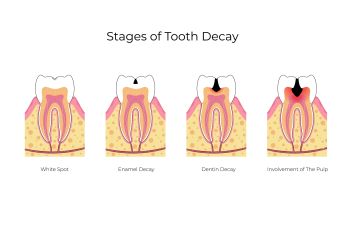
Cavities are a common dental problem, yet many patients misunderstand what they are and how they develop. The team at our Missouri City general dentistry practice believes that proper patient education can lead to better oral hygiene and prevention, which is why we always make sure to explain and explore dental health topics with each guests who stops in for an exam or consultation.
With that in mind, we want to look at the five different stages of tooth decay. This should give patients better insight into how tooth structure can become compromised and how treatments can vary.
Stage One: The Initial Lesion
Before a full cavity develops and is visible on a dental x-ray, an initial lesion must form first. This lesion tends to appear as a bit of tooth discoloration, typically white or brown. This change in color means that the tooth has undergone demineralization at a microscopic level.
Since decay hasn't set in yet, it's possible to reverse the initial lesion through proper oral hygiene and advanced professional care. Dentists may recommend fluoride treatments or the use of dental sealants, for instance. Patients can supplements in-office care with improved oral hygiene, such as brushing and flossing after every meal.
Stage Two: Enamel Decay
As the tooth decay progresses, it eventually wears down the enamel of the tooth. This is the topmost layer of the tooth, and also one of the strongest substances in the entire body. As oral bacteria eats away at the enamel, it exposes more of the porous dentin layer underneath.
To address decay of the tooth enamel, it's common for dentists to use traditional dental restorations. Typically this means a dental filling, which comes in tooth-colored and metal forms.
Stage Three: Dentin Decay
As tooth decay spread into the dentin layer, it can result in tooth sensitivity and even discomfort when biting and chewing. Worse, the decay spreads quickly through the dentin since it is porous.
With dentin decay, more substantial dental restorations are necessary to rebuild tooth structure and prevent further damage. This typically means the use of inlays, onlays, and dental crowns, which are able to restore more of a tooth's structure than a standard filling.
Stage Four: Dental Pulp Infection
Within every tooth is a substance known as dental pulp. This soft tissue is comprised of nerves, blood vessels, and connective tissue that was essential for the initial formation of a tooth. If oral bacteria breaches the dentin and reaches the dental pulp, this can lead to a root canal infection. These can be very painful and require advanced treatment.
Endodontic therapy is required to treat a root canal infection. This means the removal of the diseased dental pulp, the filling of the pulp chamber with an inert material, and the capping of the tooth with a dental crown.
Stage Five: Abscess Formation
If a root canal infection is not treated in time, the infection can spread to other parts of the mouth. This means potential infection of the gum tissue or the jawbone. Severe inflammation and serious pain can occur if the decay reaches this stage.
The ideal treatment for this stage of tooth decay tends to be tooth extraction. This is followed by treatments for the infected tissues in the mouth. It's important to get this infection under control before considering options for tooth replacement.
Contact Fort Bend Dental
For more information about your many treatment options for tooth decay, be sure to contact our cosmetic and restorative dentistry center today. The team at Fort Bend Dental will help you smile with renewed confidence.
Posted on behalf of

